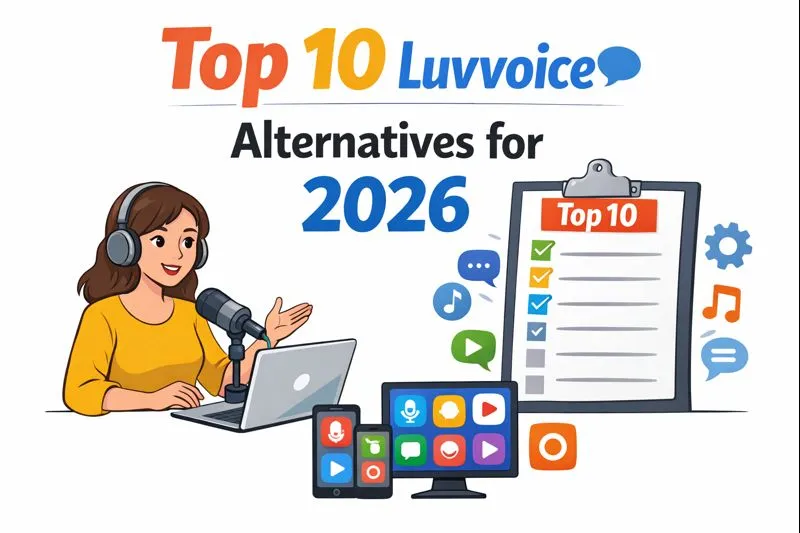Cross-Lingual Voice Transfer: Revolutionizing AI Voiceover for Video Producers
Introduction to Cross-Lingual Voice Transfer
Did you know that ai can now mimic voices across different languages? This opens up exciting possibilities for video producers aiming for global reach.
Cross-lingual voice transfer involves using ai to transfer voice characteristics, such as tone, accent, and style, from one language to another. The primary goal is to create natural-sounding voiceovers in multiple languages without needing native speakers who can perfectly replicate the desired vocal style. For example, a video producer could use an English voice to generate a Spanish voiceover that retains the original speaker's unique vocal qualities.
This technology leverages machine learning to map vocal nuances across languages. (Cross-Lingual Voice Transfer: Revolutionizing AI Voiceover for ...) Amazon Science notes the increasing interest in multilingual models for NLP and speech research.
The ability to clone a voice into another language will revolutionize content creation. Next, we'll explore the technical aspects of how this is achieved.
How Cross-Lingual Voice Transfer Works: The Technical Aspects
Ai voice cloning across languages isn't magic; it's sophisticated engineering. Let's break down the core technical concepts that make cross-lingual voice transfer possible.
Transfer learning is at the heart of cross-lingual voice transfer. (Cross-Lingual Transfer Learning for Speech Translation) It involves leveraging knowledge gained from one task, like cloning an English voice, to improve performance on another, such as cloning a Spanish voice. This approach significantly reduces the amount of training data needed for each new language.
Instead of training a new ai model from scratch for every language, transfer learning allows the model to use existing knowledge. For instance, if a model is already adept at capturing vocal nuances in English, it can adapt these skills to recognize and replicate similar features in Spanish.
Multilingual pre-trained models, like mBERT and XLM-R, play a crucial role in capturing cross-lingual similarities. These models are trained on vast amounts of text data in multiple languages, enabling them to understand linguistic patterns and relationships across different languages. mBERT (Multilingual BERT) and XLM-R (Cross-lingual Language Model RoBERTa) are large language models that have been trained on text from many languages. Their ability to grasp semantic relationships across these languages can be applied to vocal characteristics, helping the ai understand how vocal qualities might translate or be represented in different linguistic contexts.

The process involves several key components that work together seamlessly. The encoder extracts features from the source voice, such as tone, pitch, and rhythm. The decoder then generates the voiceover in the target language, guided by the encoded voice features.
The encoder analyzes the unique characteristics of the source voice, creating a detailed profile of its vocal properties. This profile includes everything from the speaker's accent and intonation to their pace and emphasis.
An intermediate layer or model often acts as a bridge, mapping the extracted features from the source language to a representation that the decoder can understand for the target language. This mapping is crucial for adapting the vocal characteristics across linguistic boundaries, often using techniques learned during transfer learning.
The decoder uses this profile to synthesize a new voiceover in the target language, ensuring that the generated speech retains the original speaker's distinct vocal qualities. This is where the magic happens, as the AI adapts its output to match the desired voice much like how a profile picture helps define and represent someone’s unique identity.
Voice embedding is a numerical representation of the voice's unique characteristics, allowing for transfer across languages. It captures the essence of a voice in a way that can be manipulated and applied to different linguistic contexts. This numerical representation specifically captures aspects like timbre (the unique "color" of the voice), pitch range, vocal fry, and even subtle breath patterns. This embedding then guides the decoder to synthesize the target language voice with those specific characteristics.
Despite its advancements, cross-lingual voice transfer faces several challenges. Phoneme mapping is crucial for addressing the differences in sound systems between languages. Additionally, accent adaptation ensures the transferred voice sounds natural in the target language's accent.
Different languages have different sets of phonemes, or basic units of sound. For example, the "th" sound in English doesn't exist in many other languages, and sounds like the French "r" or the Spanish rolled "r" have no direct equivalent in English. The ai must accurately map the phonemes of the source language to those of the target language to ensure correct pronunciation, which can be tricky when direct equivalents aren't available.
Even within the same language, accents can vary significantly. The ai needs to adapt the transferred voice to match the specific accent of the target language, enhancing the naturalness and authenticity of the generated speech.
Understanding these technical aspects provides insight into the complexities and potential of cross-lingual voice transfer. Next, we’ll explore the practical applications of this technology across various industries.
Use Cases: Where Cross-Lingual Voice Transfer Shines
Did you know that cross-lingual voice transfer can open doors to global markets you never thought possible? Let's explore how this technology shines across various industries, making video production more accessible and impactful.
Cross-lingual voice transfer is revolutionizing how organizations deliver training. Companies can now localize training materials for international employees, ensuring everyone receives consistent and easily understandable content, regardless of their native language.
Imagine a multinational corporation rolling out a new software system. Instead of hiring voice actors for each language, they can use ai to translate the training videos, maintaining the same engaging tone and style.
It also allows for creating accessible e-learning content for diverse learners. This ensures that individuals with different language proficiencies can benefit from the same high-quality educational resources.
The result is a consistent training experience across different languages, which improves knowledge retention and overall employee performance.
Marketing videos are a powerful tool, and cross-lingual voice transfer amplifies their reach. Companies can adapt marketing campaigns for global markets, creating engaging promotional videos in multiple languages without the hefty costs of traditional voiceover production.
A fashion brand launching a new collection can create videos in multiple languages. By maintaining a consistent brand voice, they can resonate with diverse audiences and increase brand awareness.
Cross-lingual voice transfer ensures that promotional videos are not only translated but also culturally adapted, making them more appealing to local markets. This drives sales and enhances brand loyalty in international markets.
Consider a tech company showcasing a new product; they can use cross-lingual voice transfer to create demos in multiple languages, ensuring the message is clear and impactful for every viewer.
Accessibility is key for documentaries and explainer videos, and cross-lingual voice transfer makes informative content available to a wider audience. This technology allows for localizing documentaries for international film festivals and distribution, increasing their reach and impact.
A science channel can create explainer videos in multiple languages. By doing so, they can foster global understanding of complex topics.
Imagine a historical documentary being adapted for different regions. Cross-lingual voice transfer ensures that the narration retains its original tone and emotional impact, regardless of the language.
This ultimately makes educational content more accessible and engaging for viewers worldwide.
Cross-lingual voice transfer is transforming video production, making it easier than ever to reach and engage with global audiences. Next, we'll discuss how to choose the right tool for your needs.
Choosing the Right Cross-Lingual Voice Transfer Tool
Selecting the right cross-lingual voice transfer tool can make or break your video production process. But with so many options available, how do you choose the one that best fits your needs?
When evaluating cross-lingual voice transfer tools, consider these key features to ensure optimal performance and usability.
Voice Quality: Look for tools that produce realistic and natural-sounding voices in multiple languages. The ai-generated voice should closely resemble human speech, with appropriate intonation, rhythm, and emotional expression. High-quality voice output is essential for maintaining viewer engagement and credibility.
Language Support: Ensure the tool supports a wide range of languages and accents relevant to your target audience. The ability to handle various linguistic nuances and regional dialects is crucial for effective localization. For instance, a tool that supports multiple Spanish accents (e.g., Mexican, Spanish, Argentinian) will be more versatile.
Customization Options: The best tools offer options to fine-tune voice parameters such as pitch, speed, and tone. This level of control allows you to tailor the voiceover to match the specific style and mood of your video content.
Ease of Use: Opt for a tool with a user-friendly interface and seamless integration with video editing software. An intuitive platform will streamline your workflow and reduce the learning curve, allowing you to focus on content creation rather than technical complexities.
Kveeky offers a comprehensive ai voiceover solution that caters to various needs.
AI scriptwriting services help you craft compelling narratives tailored for different audiences, directly addressing the need for clear and translatable content.
Voiceover services in multiple languages ensure your content resonates globally, fulfilling the language support criteria.
Customizable voice options let you fine-tune the ai-generated voice to match your brand's unique style, directly addressing the customization options we discussed.
Text-to-speech generation allows you to quickly convert written scripts into natural-sounding audio, contributing to overall voice quality.
A user-friendly interface simplifies script and voice selection, making the entire process seamless, which aligns with the ease of use requirement.
You can even start with a free trial with no credit card required, allowing you to test the platform's capabilities risk-free.
The best way to find the right tool is to test it yourself.
Take advantage of free trials and demos to evaluate features and usability firsthand. This hands-on experience will give you a clear understanding of the tool's capabilities and limitations.
Read reviews and compare user experiences to make an informed decision. User feedback can provide valuable insights into the tool's performance in real-world scenarios.
Testing different platforms allows you to assess voice quality and language support, ensuring the tool meets your specific requirements.
By carefully evaluating these aspects, you can choose a cross-lingual voice transfer tool that enhances your video production workflow and expands your global reach. Next, we'll discuss best practices for using this technology.
Best Practices for Using Cross-Lingual Voice Transfer
Harnessing the full potential of cross-lingual voice transfer requires more than just selecting the right tool. Optimizing scripts, carefully selecting voices, and rigorous quality assurance are crucial steps to ensure your video content resonates with global audiences.
Crafting scripts that translate well is the first step to effective cross-lingual voice transfer. This involves using language that is clear, concise, and universally understandable.
Opt for straightforward sentence structures and avoid complex grammatical constructions. Clear language reduces ambiguity and simplifies the translation process.
Steer clear of idioms, colloquialisms, and culture-specific references that might not resonate or translate accurately in other languages. For example, a phrase that is common in American English might be confusing or nonsensical in another culture.
Provide clear context and explanations for technical terms or industry-specific jargon. This ensures that the translated voiceover is accurate and easily understood by viewers from different backgrounds.
Choosing the right voice and customizing it to fit your content is vital for creating engaging voiceovers. This involves considering the target audience and the specific tone you want to convey.
Select voices that align with your target audience and the content's overall message. A formal, authoritative voice might be suitable for a corporate training video, while a friendly, conversational voice may be better for a marketing campaign.
Fine-tune voice parameters like pitch, speed, and tone to achieve the desired emotional impact. Adjusting these elements can significantly enhance the expressiveness and authenticity of the generated voiceover.
Ensure the voiceover sounds natural and engaging in the target language. This often requires working with native speakers to assess the rhythm, intonation, and overall flow of the translated speech. For instance, native speakers might be asked to rate the naturalness of specific phrases on a scale, or provide feedback on awkward phrasing that an ai might miss. They can also help identify subtle intonation patterns that are crucial for conveying the intended meaning.
Quality assurance is the final, critical step in the cross-lingual voice transfer process. This involves carefully reviewing the generated voiceover and making any necessary adjustments.
Listen attentively to the generated voiceover to identify any errors, inconsistencies, or unnatural-sounding phrases. Pay close attention to pronunciation, intonation, and overall clarity.
Gather feedback from native speakers to ensure the voiceover is accurate, culturally appropriate, and sounds natural. Native speakers can provide invaluable insights into the nuances of the target language and culture.
Make any necessary adjustments based on the feedback received. This may involve refining the script, tweaking voice parameters, or even selecting a different voice altogether to achieve the desired level of quality.
By following these best practices, video producers can leverage cross-lingual voice transfer to create high-quality, engaging content that resonates with global audiences. Next, we'll explore the future of this technology.
The Future of Cross-Lingual Voice Transfer
Cross-lingual voice transfer is rapidly evolving, promising a future where language barriers in video production become a thing of the past. What can we expect as ai and machine learning continue to advance?
We can anticipate continued improvements in voice quality and naturalness, making ai-generated voiceovers virtually indistinguishable from human speech. This will involve refining algorithms to better capture the nuances of human emotion and expression.
The development of more sophisticated algorithms for phoneme mapping and accent adaptation will allow for seamless voice transfer across diverse languages and dialects. This means ai will be able to handle complex linguistic variations with greater accuracy.
Expect the integration of ai voiceover with other ai-powered video editing tools, streamlining the entire video production process. This could include automated script translation, lip-syncing, and scene adaptation for different cultural contexts.
Cross-lingual voice transfer will lead to the democratization of multilingual video production, making it accessible to small businesses and independent content creators. No longer will a big budget be a barrier to reaching a global audience.
The technology will lead to increased accessibility to global markets for video content creators, opening up new revenue streams and opportunities for growth. Video producers can easily tailor content to appeal to diverse cultural preferences.
New opportunities for innovation and creativity in video production will emerge as producers experiment with ai to push the boundaries of storytelling and engagement. This could involve creating interactive videos where viewers can select their preferred language or even customize the voiceover.
The rise of cross-lingual voice transfer also brings forth important ethical considerations.
We must address concerns about voice cloning and intellectual property, ensuring that individuals' voices are not used without their consent. Clear legal frameworks and industry standards will be needed to protect voice rights. Potential solutions could involve digital watermarking of ai-generated voices, robust consent mechanisms, and clear attribution requirements. Discussions are already happening around establishing these standards to prevent misuse.
It's crucial to ensure transparency and responsible use of ai voiceover technology, avoiding potential misuse for misinformation or deceptive purposes. This includes clearly labeling ai-generated content and implementing safeguards against malicious use.
We can expect to see new applications of cross-lingual voice transfer in other industries, such as education, healthcare, and customer service. Imagine personalized language learning apps or ai-powered translation services for medical consultations.
With ongoing advancements and responsible implementation, cross-lingual voice transfer holds the potential to transform video production. As ai continues to evolve, it will be exciting to see how this technology reshapes the way we communicate and connect across cultures.





